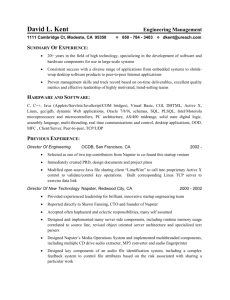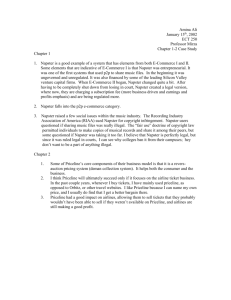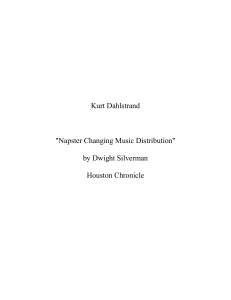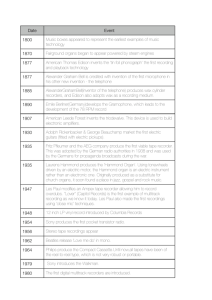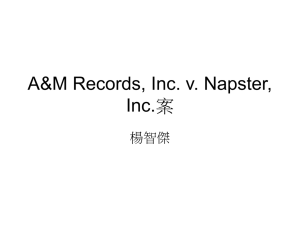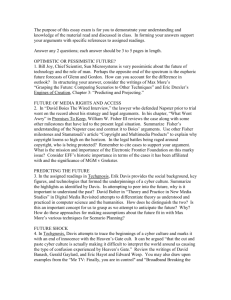A&M Records v. Napster, Inc., 2000 WL 573136
advertisement
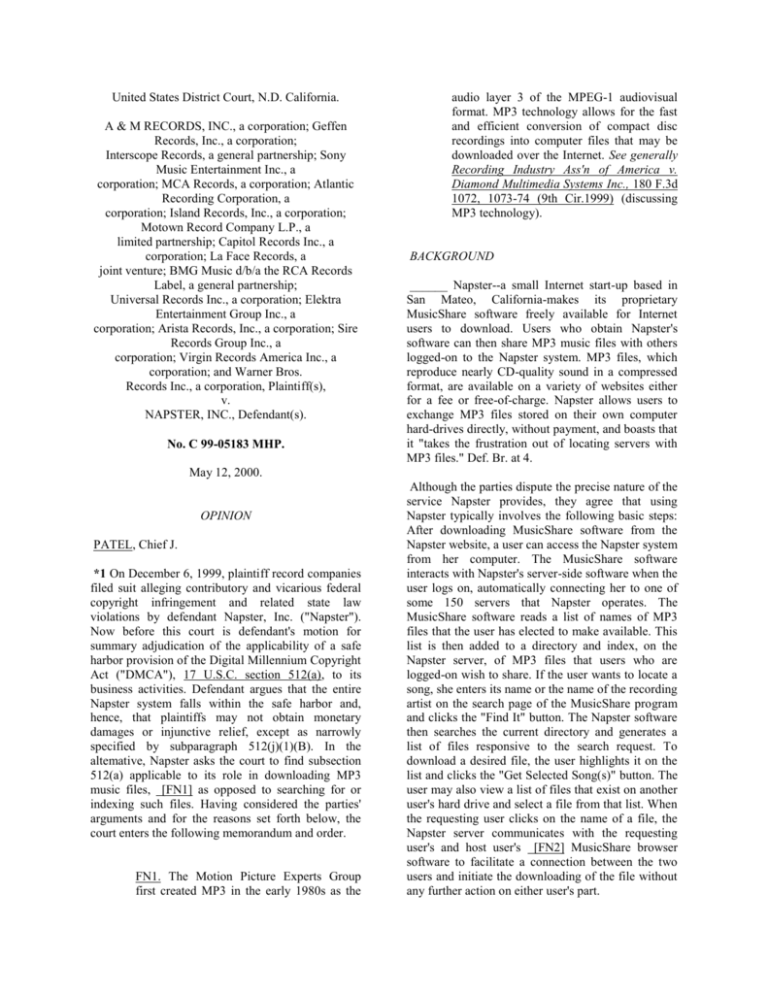
United States District Court, N.D. California. A & M RECORDS, INC., a corporation; Geffen Records, Inc., a corporation; Interscope Records, a general partnership; Sony Music Entertainment Inc., a corporation; MCA Records, a corporation; Atlantic Recording Corporation, a corporation; Island Records, Inc., a corporation; Motown Record Company L.P., a limited partnership; Capitol Records Inc., a corporation; La Face Records, a joint venture; BMG Music d/b/a the RCA Records Label, a general partnership; Universal Records Inc., a corporation; Elektra Entertainment Group Inc., a corporation; Arista Records, Inc., a corporation; Sire Records Group Inc., a corporation; Virgin Records America Inc., a corporation; and Warner Bros. Records Inc., a corporation, Plaintiff(s), v. NAPSTER, INC., Defendant(s). No. C 99-05183 MHP. audio layer 3 of the MPEG-1 audiovisual format. MP3 technology allows for the fast and efficient conversion of compact disc recordings into computer files that may be downloaded over the Internet. See generally Recording Industry Ass'n of America v. Diamond Multimedia Systems Inc., 180 F.3d 1072, 1073-74 (9th Cir.1999) (discussing MP3 technology). BACKGROUND ______ Napster--a small Internet start-up based in San Mateo, California-makes its proprietary MusicShare software freely available for Internet users to download. Users who obtain Napster's software can then share MP3 music files with others logged-on to the Napster system. MP3 files, which reproduce nearly CD-quality sound in a compressed format, are available on a variety of websites either for a fee or free-of-charge. Napster allows users to exchange MP3 files stored on their own computer hard-drives directly, without payment, and boasts that it "takes the frustration out of locating servers with MP3 files." Def. Br. at 4. May 12, 2000. OPINION PATEL, Chief J. *1 On December 6, 1999, plaintiff record companies filed suit alleging contributory and vicarious federal copyright infringement and related state law violations by defendant Napster, Inc. ("Napster"). Now before this court is defendant's motion for summary adjudication of the applicability of a safe harbor provision of the Digital Millennium Copyright Act ("DMCA"), 17 U.S.C. section 512(a), to its business activities. Defendant argues that the entire Napster system falls within the safe harbor and, hence, that plaintiffs may not obtain monetary damages or injunctive relief, except as narrowly specified by subparagraph 512(j)(1)(B). In the altemative, Napster asks the court to find subsection 512(a) applicable to its role in downloading MP3 music files, [FN1] as opposed to searching for or indexing such files. Having considered the parties' arguments and for the reasons set forth below, the court enters the following memorandum and order. FN1. The Motion Picture Experts Group first created MP3 in the early 1980s as the Although the parties dispute the precise nature of the service Napster provides, they agree that using Napster typically involves the following basic steps: After downloading MusicShare software from the Napster website, a user can access the Napster system from her computer. The MusicShare software interacts with Napster's server-side software when the user logs on, automatically connecting her to one of some 150 servers that Napster operates. The MusicShare software reads a list of names of MP3 files that the user has elected to make available. This list is then added to a directory and index, on the Napster server, of MP3 files that users who are logged-on wish to share. If the user wants to locate a song, she enters its name or the name of the recording artist on the search page of the MusicShare program and clicks the "Find It" button. The Napster software then searches the current directory and generates a list of files responsive to the search request. To download a desired file, the user highlights it on the list and clicks the "Get Selected Song(s)" button. The user may also view a list of files that exist on another user's hard drive and select a file from that list. When the requesting user clicks on the name of a file, the Napster server communicates with the requesting user's and host user's [FN2] MusicShare browser software to facilitate a connection between the two users and initiate the downloading of the file without any further action on either user's part. FN2. Napster uses the term "host user" to refer to the user who makes the desired MP3 file available for downloading. *2 According to Napster, when the requesting user clicks on the name of the desired MP3 file, the Napster server routes this request to the host user's browser. The host user's browser responds that it either can or cannot supply the file. If the host user can supply the file, the Napster server communicates the host's address and routing information to the requesting user's browser, allowing the requesting user to make a connection with the host and receive the desired MP3 file. See Declaration of Edward Kessler ("Kessler Dec."), Exh. B; Reply Declaration of Edward Kessler ("Kessler Reply Dec.") § 22. The parties disagree about whether this process involves a hypertext link that the Napster server-side software provides. Compare Pl. Br. at 9 with Def. Reply Br. at 10 n.12. However, plaintiffs admit that the Napster server gets the necessary IP address information from the host user, enabling the requesting user to connect to the host. See Declaration of Daniel Farmer ("Farmer Dec.") § 17; Declaration of Russell. J. Frackman ("Frackman Dec."), Exh. 1 (Kessler Dep.) at 103-05. The MP3 file is actually transmitted over the Internet, see, e.g., Def. Reply Br. at 3, but the steps necessary to make that connection could not take place without the Napster server. The Napster system has other functions besides allowing users to search for, request, and download MP3 files. For example, a requesting user can play a downloaded song using the MusicShare software. Napster also hosts a chat room. Napster has developed a policy that makes compliance with all copyright laws one of the "terms of use" of its service and warns users that: Napster will terminate the accounts of users who are repeat infringers of the copyrights, or other intellectual property rights, of others. In addition, Napster reserves the right to terminate the account of a user upon any single infringement of the rights of others in conjunction with use of the Napster service. Kessler Dec. § 19. However, the parties disagree over when this policy was instituted and how effectively it bars infringers from using the Napster service. Napster claims that it had a copyright compliance policy as early as October 1999, but admits that it did not document or notify users of the existence of this policy until February 7, 2000. ________ LEGAL STANDARD The court may grant summary adjudication of a particular claim or defense under the same standards used to consider a summary judgment motion. See Fed.R.Civ.P. 56(a), (b); Pacific Fruit Express Co. v. Akron, Canton & Youngstown R.R. Co., 524 F.2d 1025, 1029-30 (9th Cir.1975). Summary judgment shall be granted when there is no genuine issue of material fact and the movant is entitled to judgment as a matter of law. See Fed. R. Civ. 56(c). The moving party bears the initial burden of identifying those portions of the record that demonstrate the absence of a genuine issue of material fact. The burden then shifts to the nonmoving party to "go beyond the pleadings, and by [its] own affidavits, or by the 'depositions, answers to interrogatories, or admissions on file,' designate 'specific facts showing that there is a genuine issue for trial." ' Celotex Corp. v. Catrett, 477 U.S. 317, 324 (1986) (citations omitted). A dispute about a material fact is genuine "if the evidence is such that a reasonable jury could return a verdict for the nonmoving party." Anderson v. Liberty Lobby, Inc., 477 U.S. 242, 248 (1986). The moving party discharges its burden by showing that the nonmoving party has not disclosed the existence of any "significant probative evidence tending to support the complaint." First Nat'l Bank v. Cities Serv. Co., 391 U.S. 253, 290 (1968). The court does not make credibility determinations in considering a motion for summary judgment. See Anderson, 477 U.S. at 249. Rather, it views the inferences drawn from the facts in the light most favorable to the party opposing the motion. See T.W. Elec. Serv., Inc. v. Pacific Elec. Contractor's Ass'n, 809 F.2d 626, 631 (9th Cir.1987). DISCUSSION *3 Section 512 of the DMCA addresses the liability of online service and Internet access providers for copyright infringements occurring online. Subsection 512(a) exempts qualifying service providers from monetary liability for direct, vicarious, and contributory infringement and limits injunctive relief to the degree specified in subparagraph 512(j)(1)(B). Interpretation of subsection 512(a), or indeed any of the section 512 safe harbors, appears to be an issue of first impression. [FN3] FN3. In Universal City Studios, Inc. v. Reimerdes, 82 F.Supp.2d 211, 217 & n.17 (S.D.N.Y 2000), one defendant sought protection under subsection 512(c). Although the court noted in passing that the defendant offered no evidence that he was a service provider under subsection 512(c), it held that he could not invoke the safe harbor because plaintiffs claimed violations of 17 U.S.C. section 1201(a), which applies to circumvention products and technologies, rather than copyright infringement. Napster browser and hard drive." Def. Reply Br. at 3. Second, Napster states that users choose the online communication points and the MP3 files to be transmitted with no direction from Napster. Finally, the Napster system does not modify the content of the transferred files. Defendant contends that, because it meets the definition of "service provider," [FN5] it need only satisfy the five remaining requirements of the safe harbor to prevail in its motion for summary adjudication. Napster claims that its business activities fall within the safe harbor provided by subsection 512(a). This subsection limits liability "for infringement of copyright by reason of the [service] provider's transmitting, routing, or providing connections for, material through a system or network controlled or operated by or for the service provider, or by reason of the intermediate and transient storage of that material in the course of such transmitting, routing, or providing connections," if five conditions are satisfied: (1) the transmission of the material was initiated by or at the direction of a person other than the service provider; (2) the transmission, routing, provision of connections, or storage is carried out through an automatic technical process without selection of the material by the service provider; (3) the service provider does not select the recipients of the material except as an automatic response to the request of another person; (4) no copy of the material made by the service provider in the course of such intermediate or transient storage is maintained on the system or network in a manner ordinarily accessible to anyone other than the anticipated recipients, and no such copy is maintained on the system or network in a manner ordinarily accessible to such anticipated recipients for a longer period than is reasonably necessary for the transmission, routing, or provision of connections; and (5) the material is transmitted through the system or network without modification of its content. 17 U.S.C. § 512(a). FN4. Subparagraph 512(k)(1)(A) provides: As used in subsection (a), the term "service provider" means an entity offering the transmission, routing, or providing of connections for digital online communications, between or among points specified by a user, of material of the user's choosing, without modification to the content of the material sent or received. Subparagraph 512(k)(1)(B) states: As used in this section, other than subsection (a), the term "service provider" means a provider of online services or network access, or the operator of facilities therefor, and includes an entity described in subparagraph (A). Citing the "definitions" subsection of the statute, Napster argues that it is a "service provider" for the purposes of the 512(a) safe harbor. See 17 U.S.C. § 512(k)(1)(A). [FN4] First, it claims to offer the "transmission, routing, or providing of connections for digital online communications" by enabling the connection of users' hard-drives and the transmission of MP3 files "directly from the Host hard drive and Napster browser through the Internet to the user's FN5. It is not entirely clear to the court that Napster qualifies under the narrower subparagraph 512(k)(1)(A). However, plaintiffs appear to concede that Napster is a "service provider" within the meaning of subparagraph 512(k)(1)(A), arguing instead that Napster does not satisfy the additional limitations that the prefatory language of subsection 512(a) imposes. The court assumes, but does not hold, that Napster is a "service provider" under subparagraph 512(k)(1)(A). *4 Defendant then seeks to show compliance with these requirements by arguing: (1) a Napster user, and never Napster itself, initiates the transmission of MP3 files; (2) the transmission occurs through an automatic, technical process without any editorial input from Napster; (3) Napster does not choose the recipients of the MP3 files; (4) Napster does not make a copy of the material during transmission; and (5) the content of the material is not modified during transmission. Napster maintains that the 512(a) safe harbor thus protects its core function- "transmitting, routing and providing connections for sharing of the files its users choose." Def. Reply Br. at 2. Plaintiffs disagree. They first argue that subsection 512(n) requires the court to analyze each of Napster's functions independently and that not all of these functions fall under the 512(a) safe harbor. In their view, Napster provides information location toolssuch as a search engine, directory, index, and linksthat are covered by the more stringent eligibility requirements of subsection 512(d), rather than subsection 512(a). Plaintiffs also contend that Napster does not perform the function which the 512(a) safe harbor protects because the infringing material is not transmitted or routed through the Napster system, as required by subsection 512(a). They correctly note that the definition of "service provider" under subparagraph 512(k)(1)(A) is not identical to the prefatory language of subsection 512(a). The latter imposes the additional requirement that transmitting, routing, or providing connections must occur "through the system or network." Plaintiffs argue in the alternative that, if users' computers are part of the Napster system, copies of MP3 files are stored on the system longer than reasonably necessary for transmission, and thus subparagraph 512(a)(4) is not satisfied. Finally, plaintiffs note that, under the general eligibility requirements established in subsection 512(i), a service provider must have adopted, reasonably implemented, and informed its users of a policy for terminating repeat infringers. Plaintiffs contend that Napster only adopted its copyright compliance policy after the onset of this litigation and even now does not discipline infringers in any meaningful way. Therefore, in plaintiffs' view, Napster fails to satisfy the DMCA's threshold eligibility requirements or show that the 512(a) safe harbor covers any of its functions. I. Independent Analysis of Functions Subsection 512(n) of the DMCA states: Subsections (a), (b), (c), and (d) describe separate and distinct functions for purposes of applying this section. Whether a service provider qualifies for the limitation on liability in any one of those subsections shall be based solely on the criteria in that subsection and shall not affect a determination of whether that service provider qualifies for the limitations on liability under any other such subsections. *5 Citing subsection 512(n), plaintiffs argue that the 512(a) safe harbor does not offer blanket protection to Napster's entire system. Plaintiffs consider the focus of the litigation to be Napster's function as an information location tool-eligible for protection, if at all, under the more rigorous subsection 512(d). They contend that the system does not operate as a passive conduit within the meaning subsection 512(a). In this view, Napster's only possible safe harbor is subsection 512(d), which applies to service providers "referring or linking users to an online location containing infringing material or infringing activity, by using information location tools, including a directory, index, reference, pointer, or hypertext link...." Subsection 512(d) imposes more demanding eligibility requirements because it covers active assistance to users. Defendant responds in two ways. First, it argues that subsection 512(a), rather than 512(d), applies because the information location tools it provides are incidental to its core function of automatically transmitting, routing, or providing connections for the MP3 files users select. In the alternative, defendant maintains that, even if the court decides to analyze the information location functions under 512(d), it should hold that the 512(a) safe harbor protects other aspects of the Napster service. Napster undisputedly performs some information location functions. The Napster server stores a transient list of the files that each user currently logged-on to that server wants to share. See, e .g., Kessler Dec. § 12. This data is maintained until the user logs off, but the structure of the index itself continues to exist. See Frackman Dec., Exh. 1 (Kessler Dep.), at 71:3-4, 16-21; 77:8. If a user wants to find a particular song or recording artist, she enters a search, and Napster looks for the search terms in the index. See id. at 76:17-25, 77:12. Edward Kessler, Napster's Vice President of Engineering, admitted in his deposition that, at least in this context, Napster functions as a free information location tool. See id. at 21:12-19; cf. Farmer Dec. § 16 (stating that "Napster operates exactly like a search engine or information location tool to the user"). Napster software also has a "hot list" function that allows users to search for other users' log-in names and receive notification when users with whom they might want to communicate have connected to the service. See Frackman Dec., Exh. 1 (Kessler Dep.), at 59:16-18. In short, the parties agree on the existence of a searchable directory and index, and Napster representatives have used the phrase "information location tool," which appears in the heading for subsection 512(d), to characterize some Napster functions. There the agreement ends. According to Napster, the information location tools upon which plaintiffs base their argument are incidental to the system's core function of transmitting MP3 music files, and for this reason, the court should apply subsection 512(a). Napster also disputes the contention that it organizes files or provides links to other Internet sites in the same manner as a search engine like Yahoo!. See Kessler Reply Dec. § § 16-20 (discussing differences between Napster and other search engines). Consequently, it deems subsection 512(d) inapplicable to its activities. Cf. H.R.Rep. No. 105-551(II), 105th Cong., 2d Sess. (1998), 1998 WL 414916, at *147 (using Yahoo! as an example of an information location tool covered by 512(d)). Napster contrasts its operations, which proceed automatically after initial stimuli from users, with search engines like Yahoo! that depend upon the "human judgment and editorial discretion" of the service provider's staff. Id. *6 Napster's final and most compelling argument regarding subsection 512(d) is that the DMCA safe harbors are not mutually exclusive. According to subsection 512(n), a service provider could enjoy the 512(a) safe harbor even if its information location tools were also protected by (or failed to satisfy) subsection 512(d). See 17 U.S.C. § 512(n) ("Whether a service provider qualifies for the limitation on liability in any one of those subsections ... shall not affect a determination of whether that service provider qualifies for the limitations on liability under any other such subsections.") Similarly, finding some aspects of the system outside the scope of subsection 512(a) would not preclude a ruling that other aspects do meet 512(a) criteria. Because the parties dispute material issues regarding the operation of Napster's index, directory, and search engine, the court declines to hold that these functions are peripheral to the alleged infringement, or that they should not be analyzed separately under subsection 512(d). [FN6] Indeed, despite its contention that its search engine and indexing functions are incidental to the provision of connections and transmission of MP3 files, Napster has advertised the ease with which its users can locate "millions of songs" online without "wading through page after page of unknown artists." Frackman Dec., Exh. 5, 4. Such statements by Napster to promote its service are tantamount to an admission that its search and indexing functions are essential to its marketability. Some of these essential functions-including but not limited to the search engine and index-should be analyzed under subsection 512(d). FN6. The court need not rule on the applicability of subsection 512(d) to the functions plaintiffs characterize as information location tools because defendant does not rely on subsection 512(d) as grounds for its motion for summary adjudication. However, the potential applicability of subsection 512(d) does not completely foreclose use of the 512(a) safe harbor as an affirmative defense. See 17 U.S.C. § 512(n). The court will now turn to Napster's eligibility for protection under subsection 512(a). It notes at the outset, though, that a ruling that subsection 512(a) applies to a given function would not mean that the DMCA affords the service provider blanket protection. II. Subsection 512(a) Plaintiffs' principal argument against application of the 512(a) safe harbor is that Napster does not perform the passive conduit function eligible for protection under this subsection. As defendant correctly notes, the words "conduit" or "passive conduit" appear nowhere in 512(a), but are found only in the legislative history and summaries of the DMCA. The court must look first to the plain language of the statute, "construing the provisions of the entire law, including its object and policy, to ascertain the intent of Congress." United States v. Hockings, 129 F.3d 1069, 1071 (9th Cir.1997) (quoting Northwest Forest Resource Council v. Glickman, 82 F.3d 825, 830 (9th Cir.1996)) (internal quotation marks omitted). If the statute is unclear, however, the court may rely on the legislative history. See Hockings, 129 F.3d at 1071. The language of subsection 512(a) makes the safe harbor applicable, as a threshold matter, to service providers "transmitting, routing or providing connections for, material through a system or network controlled or operated by or for the service provider...." 17 U.S.C. § 512(a) (emphasis added). According to plaintiffs, the use of the word "conduit" in the legislative history explains the meaning of "through a system." *7 Napster has expressly denied that the transmission of MP3 files ever passes through its servers. See Kessler Dec. § 14. Indeed, Kessler declared that "files reside on the computers of Napster users, and are transmitted directly between those computers." Id. MP3 files are transmitted "from the Host user's hard drive and Napster browser, through the Internet to the recipient's Napster browser and hard drive." Def. Reply Br. at 3 (citing Kessler Dec. § 12-13) (emphasis added). The Internet cannot be considered "a system or network controlled or operated by or for the service provider," however. 17 U.S.C. § 512(a). To get around this problem, Napster avers (and plaintiffs seem willing to concede) that "Napster's servers and Napster's MusicShare browsers on its users' computers are all part of Napster's overall system." Def. Reply Br. at 5. Defendant narrowly defines its system to include the browsers on users' computers. See Kessler Dec. § 13. In contrast, plaintiffs argue that either (1) the system does not include the browsers, or (2) it includes not only the browsers, but also the users' computers themselves. See Farmer Dec. § 17. Even assuming that the system includes the browser on each user's computer, the MP3 files are not transmitted "through" the system within the meaning of subsection 512(a). Napster emphasizes the passivity of its role-stating that "[a]ll files transfer directly from the computer of one Napster user through the Internet to the computer of the requesting user." Def. Br. at 5 (emphasis added); see also id. at 12 (citing Kessler Dec. § 13-15). It admits that the transmission bypasses the Napster server. See Kessler Dec. § 14; Def. Reply Br. at 6. This means that, even if each user's Napster browser is part of the system, the transmission goes from one part of the system to another, or between parts of the system, but not "through" the system. The court finds that subsection 512(a) does not protect the transmission of MP3 files. The prefatory language of subsection 512(a) is disjunctive, however. The subsection applies to "infringement of copyright by reason of the provider's transmitting, routing, or providing connections through a system or network controlled or operated by or for the service provider." 17 U.S.C. § 512(a) (emphasis added). The court's finding that transmission does not occur "through" the system or network does not foreclose the possibility that subsection 512(a) applies to "routing" or "providing connections." Rather, each of these functions must be analyzed independently. Napster contends that providing connections between users' addresses "constitutes the value of the system to the users and the public." Def. Br. at 15. This connection cannot be established without the provision of the host's address to the Napster browser software installed on the requesting user's computer. See Kessler Dec. § 10-13. The central Napster server delivers the host's address. See id. While plaintiffs contend that the infringing material is not transmitted through the Napster system, they provide no evidence to rebut the assertion that Napster supplies the requesting user's computer with information necessary to facilitate a connection with the host. *8 Nevertheless, the court finds that Napster does not provide connections "through" its system. Although the Napster server conveys address information to establish a connection between the requesting and host users, the connection itself occurs through the Internet. The legislative historyof section 512 demonstrates that Congress intended the 512(a) safe harbor to apply only to activities "in which a service provider plays the role of a 'conduit' for the communications of others." H.R.Rep. No. 105551(II), 105th Cong., 2d Sess. (1998), 1998 WL 414916, at *130. Drawing inferences in the light most favorable to the non-moving party, this court cannot say that Napster serves as a conduit for the connection itself, as opposed to the address information that makes the connection possible. Napster enables or facilitates the initiation of connections, but these connections do not pass through the system within the meaning of subsection 512(a). Neither party has adequately briefed the meaning of "routing" in subsection 512(a), nor does the legislative history shed light on this issue. Defendant tries to make "routing" and "providing connections" appear synonymous-stating, for example, that "the central Napster server routes the transmission by providing the Host's address to the Napster browser that is installed on and in use by Userl's computer." Def. Br. at 16. However, the court doubts that Congress would have used the terms "routing" and "providing connections" disjunctively if they had the same meaning. [FN7] It is clear from both parties' submissions that the route of the allegedly infringing material goes through the Internet from the host to the requesting user, not through the Napster server. See, e.g., Def. Br. at 13 ("Indeed, the content of the MP3 files are routed without even passing through Napster's Servers."). The court holds that routing does not occur through the Napster system. FN7. Napster sometimes appears to recognize a distinction between the two terms. For example, it states that "the system provides remote users with connection to each other and allows them to transmit and route the information as they choose." Def. Reply Br. at 2. Because Napster does not transmit, route, or provide connections through its system, it has failed to demonstrate that it qualifies for the 512(a) safe harbor. The court thus declines to grant summary adjudication in its favor. III. Copyright Compliance Policy Even if the court had determined that Napster meets the criteria outlined in subsection 512(a), subsection 512(i) imposes additional requirements on eligibility for any DMCA safe harbor. This provision states: The limitations established by this section shall apply to a service provider only if the service provider(A) has adopted and reasonably implemented, and informs subscribers and account holders of the service provider's system or network of, a policy that provides for the termination in appropriate circumstances of subscribers and account holders of the service provider's system or network who are repeat infringers; and (B) accommodates and does not interfere with standard technical measures. 17 U.S.C. § 512(i). *9 Plaintiffs challenge Napster's compliance with these threshold eligibility requirements on two grounds. First, they point to evidence from Kessler's deposition that Napster did not adopt a written policy of which its users had notice until on or around February 7, 2000-two months after the filing of this lawsuit. See Frackman Dec., Exh. 1 (Kessler Dep.) at 189:17-25, 190:1-25, 191:1-12. Kessler testified that, although Napster had a copyright compliance policy as early as October 1999, he is not aware that this policy was reflected in any document, see id. at 191:22-24, 192:9-11, or communicated to any user. See id. at 192:15-16. Congress did not intend to require a service provider to "investigate possible infringements, monitor its service or make difficult judgments as to whether conduct is or is not infringing," but the notice requirement is designed to insure that flagrant or repeat infringers "know that there is a realistic threat of losing [their] access." H.R. Rep. 105-551(II), 1998 WL 414916, at *154. Napster attempts to refute plaintiffs' argument by noting that subsection 512(i) does not specify when the copyright compliance policy must be in place. Although this characterization of subsection 512(i) is facially accurate, it defies the logic of making formal notification to users or subscribers a prerequisite to exemption from monetary liability. The fact that Napster developed and notified its users of a formal policy after the onset of this action should not moot plaintiffs' claim to monetary relief for past harms. Without further documentation, defendant's argument that it has satisfied subsection 512(i) is merely conclusory and does not support summary adjudication in its favor. Summary adjudication is also inappropriate because Napster has not shown that it reasonably implemented a policy for terminating repeat infringers. See 17 U.S.C. § 512(i)(A) (requiring "reasonable" implementation of such a policy). If Napster is formally notified of infringing activity, it blocks the infringer's password so she cannot log on to the Napster service using that password. See Kessler Dec. § 23. Napster does not block the IP addresses of infringing users, however, and the parties dispute whether it would be feasible or effective to do so. See Frackman Dec., Exh. 1 (Kessler Dep.), at 205:4-7. Plaintiffs aver that Napster wilfully turns a blind eye to the identity of its users--that is, their real names and physical addresses--because their anonymity allows Napster to disclaim responsibility for copyright infringement. Hence, plaintiffs contend, "infringers may readily reapply to the Napster system to recommence their infringing downloading and uploading of MP3 music files." Pl. Br. at 24. Plaintiffs' expert, computer security researcher Daniel Farmer, declared that he conducted tests in which he easily deleted all traces of his former Napster identity, convincing Napster that "it had never seen me or my computer before ." Farmer Dec. § 29. Farmer also cast doubt on Napster's contention that blocking IP addresses is not a reasonable means of terminating infringers. He noted that Napster bans the IP addresses of users who runs "bots" [FN8] on the service. See id. § 27. FN8. Farmer informed that court that "A 'bot' is a robot, or program, that performs actions continuously, in a sort of manic or robotic fashion." Farmer Dec. § 27. *10 Hence, plaintiffs raise genuine issues of material fact about whether Napster has reasonably implemented a policy of terminating repeat infringers. They have produced evidence that Napster's copyright compliance policy is neither timely nor reasonable within the meaning of subparagraph 512(i)(A). CONCLUSION This court has determined above that Napster does not meet the requirements of subsection 512(a) because it does not transmit, route, or provide connections for allegedly infringing material through its system. The court also finds summary adjudication inappropriate due to the existence of genuine issues of material fact about Napster's compliance with subparagraph 512(i)(A), which a service provider must satisfy to enjoy the protection of any section 512 safe harbor. Defendant's motion for summary adjudication is DENIED. IT IS SO ORDERED. END OF DOCUMENT
